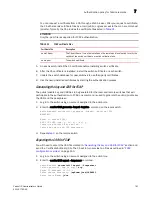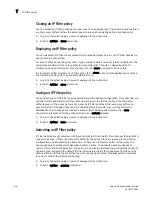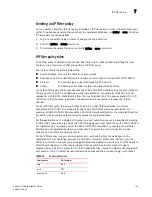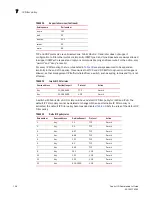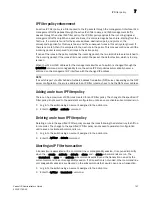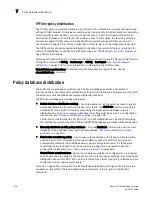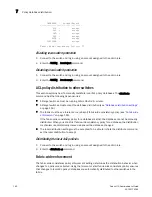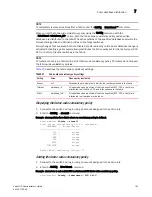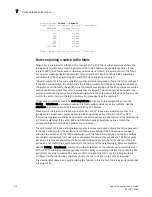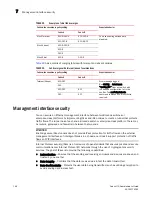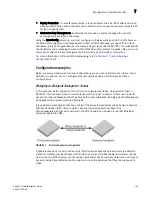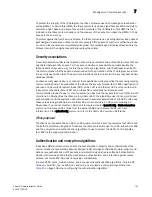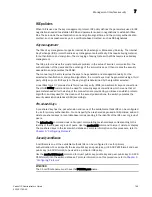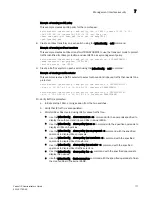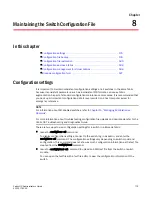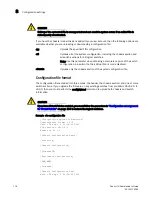
164
Fabric OS Administrator’s Guide
53-1001763-02
Management interface security
7
Table 40
has a matrix of merging fabrics with tolerant and absent policies.
Management interface security
You can secure an Ethernet management interface between two Brocade switches or
enterprise-class platforms by implementing IPsec and IKE policies to create a tunnel that protects
traffic flows. The tunnel has at each end a Brocade switch or enterprise-class platform. There may
be routers, gateways, and firewalls in between the two ends.
ATTENTION
Enabling secure IPsec tunnels does not provide IPsec protection for traffic flows on the external
management interfaces of intelligent blades in a chassis, nor does it support protection of traffic
flows on FCIP interfaces.
Internet Protocol security (IPsec) is a framework of open standards that ensures private and secure
communications over Internet Protocol (IP) networks through the use of cryptographic security
services. The goal of IPsec is to provide the following capabilities:
•
Authentication — Ensures that the sending and receiving end-users and devices are known and
trusted by one another.
•
Data Integrity — Confirms that the data received was in fact the data transmitted.
•
Data Confidentiality — Protects the user data being transmitted, such as utilizing encryption to
avoid sending data in clear text.
TABLE 39
Examples of strict fabric merges
Fabric-wide consistency policy setting
Expected behavior
Fabric A
Fabric B
Strict/Tolerant
SCC:S;DCC:S
SCC;DCC:S
Ports connecting switches are
disabled.
SCC;DCC:S
SCC:S;DCC
Strict/Absent
SCC:S;DCC:S
SCC:S
DCC:S
Strict/Strict
SCC:S
DCC:S
TABLE 40
Fabric merges with tolerant/absent combinations
Fabric-wide consistency policy setting
Expected behavior
Fabric A
Fabric B
Tolerant/Absent
SCC;DCC
Error message logged.
Run fddCfg
--
fabwideset
“<policy_ID>” from any switch with
the desired configuration to fix the
conflict. The secPolicyActivate
command is blocked until conflict is
resolved.
DCC
SCC;DCC
SCC
DCC
SCC
Summary of Contents for 53-1001763-02
Page 1: ...53 1001763 02 13 September 2010 Fabric OS Administrator s Guide Supporting Fabric OS v6 4 0 ...
Page 4: ...iv Fabric OS Administrator s Guide 53 1001763 02 ...
Page 24: ...xxiv Fabric OS Administrator s Guide 53 1001763 02 ...
Page 28: ...xxviii Fabric OS Administrator s Guide 53 1001763 02 ...
Page 32: ...xxxii Fabric OS Administrator s Guide 53 1001763 02 ...
Page 40: ...xl Fabric OS Administrator s Guide 53 1001763 02 ...
Page 42: ...2 Fabric OS Administrator s Guide 53 1001763 02 ...
Page 54: ...14 Fabric OS Administrator s Guide 53 1001763 02 High availability of daemon processes 1 ...
Page 74: ...34 Fabric OS Administrator s Guide 53 1001763 02 Basic connections 2 ...
Page 102: ...62 Fabric OS Administrator s Guide 53 1001763 02 Audit log configuration 3 ...
Page 214: ...174 Fabric OS Administrator s Guide 53 1001763 02 Management interface security 7 ...
Page 228: ...188 Fabric OS Administrator s Guide 53 1001763 02 Brocade configuration form 8 ...
Page 276: ...236 Fabric OS Administrator s Guide 53 1001763 02 Creating a logical fabric using XISLs 10 ...
Page 404: ...364 Fabric OS Administrator s Guide 53 1001763 02 ...
Page 440: ...400 Fabric OS Administrator s Guide 53 1001763 02 Performance data collection 17 ...
Page 480: ...440 Fabric OS Administrator s Guide 53 1001763 02 F_Port masterless trunking 19 ...
Page 494: ...454 Fabric OS Administrator s Guide 53 1001763 02 Buffer credit recovery 20 ...
Page 574: ...534 Fabric OS Administrator s Guide 53 1001763 02 Hexadecimal overview E ...


